Lt. Roger C. Palmer
Group VIPs
Roger Palmer graduated from Kings Mill High School, Cincinnati, Ohio, in 1941. He started working at Wright Aeronautical producing aircraft engines. When World War II began, Roger and his roommate drove to the University of Kentucky campus to enlist with the Army Air Force.
On February 8, 1943, he went to the Armory in Fort Thomas, Kentucky to report for duty and from there he trained at Biloxi. After completion of primary training, a few recruits were selected to go to college at Indiana Central College. Roger was one of them and was enrolled in English and European History classes. One of the first soldiers to leave the college, Roger was sent to SAC outside Kelly Field, San Antonio, Texas, for further training.
Roger was then assigned to primary flight training at Cimmaron Field near Oklahoma City, where he flew the Fairchild PT-19’s and was taught aerobatics such as vertical reverses and half rolls. After graduating, (Class 44-B) he was sent to Enid, Oklahoma for basic flight training in Vultee BT-13’s and 15’s.
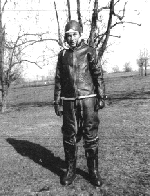
Next up was Aloe Field near Victoria, Texas were Roger flew AT-6’s. A "hotter" airplane that was harder to land, and allowed more challenging aerobatic maneuvers. When his training was completed, Roger was given his commission as a second lieutenant and a 10-day leave to visit home.
Upon his return, Roger flew Curtis P-40’s and Bell P-39’s. He didn’t like the P-40. It was not easy to fly, the controls were stiff, and he complained of poor high speed diving characteristics, as well as poor forward visability in low speed flight.
Roger was then sent to Salinas, California to wait for the next flight school at Marysville, California to start. Here Roger flew P-39’s. He remembers the Airacobra as a hot number he liked flying. The plane had a high wing loading, and landed at 90 mph, making approaches somewhat tricky. During one landing attempt, Roger had an electrical system failure. The field sent up a flare, signaling the new leutenant that he had a problem. Roger lowered the gear with the backup hand pump, and landed successfully. From there Roger went to Chico, California. It was a beautiful little town with so many trees that when flying over it all you saw was the church steeple.
While in Chico, Roger flew P-39s and was introduced to the Bell P-63 Kingcobra, a redesign of the Airacobra. The P-63 was the most enjoyable fighter Roger had ever flown. It handled nicely and landed slow.
In Santa Rose, California he met the P-38 Lightning. Here, at a navy school, Roger flew one of the most unusual and famous airplanes of all time. His most memorable experience, aside from sitting between two 1200 hp engines, was just sitting in the cockpit for ten hours, some of it blindfolded, learning where everything was located.
By July, he was sent to Hamilton Field awaiting assignment. Roger learned that he was to be assigned to the Pacific, and his trip west was to take him through such places as Wheeler Field, Hawaii, a recently secured Henderson Field, Guadalcanal, Port Moresby on British New Guinea, and finally to Biak, in Dutch New Guinea. In September 44, Roger joined up with the 475th Fighter Group ("Satan’s Angels"), and was assigned to the 432nd Squadron ("Clover") at Nadzab. He had just missed meeting Charles Lindbergh who was there the week before as a consultant for the Vought Corporation, maker of the F4U Corsair. Lindbergh had shown the squadron how to increase flight distance by reducing RPM’s and increasing manifold pressure, using less gas.
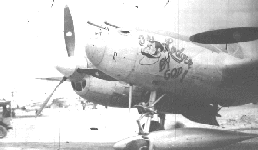
In October, the 432nd went to Tacloban in the Philippines where Roger was finally assigned his "own" plane, a P-38L-5 which was named "The Lodger by God". Roger remembers his plane as being a lucky one because it never got hit, nor did he ever have to SNAFU and return early from a mission. A fact he passes the credit for to his crew chief, William Tighe. During one mission off the East Coast of Hermosa they got into heavy anti-aircraft fire, Roger’s plane was the only one of ten planes in the flight that did not suffer any damage.
November of 1944 brought more combat and a wide range of flight assignments. Mainly patrolling and escorting bomber flights. Roger recalls that occasionally the bombers missed the rendezvous, but when they did meet, Roger’s group would escort them to their targets and watch for enemy planes. On November 10th Roger got his first shot at a Japanese plane. One of twelve planes patrolling the west side of Leyte, they found the Japanese were landing troops there. Twelve Japanese Ki-61 Tonys were flying in a tight formation. Roger’s group climbed left to come at the Tonys from above. The Flight Commander collided with his wingman, but the eight remaining 475th planes got 10 kills and one "probable". Roger hit one Tony, saw the puffs of white smoke from the leaking coolant, but no one could verify that it went down. The Flight Commander, PJ Dahl returned to base about a month later, but his wingman wasn't heard from again. December saw the squadron move to Mindinao.
January through March of 1945 was spent on escort mission to places such as Negroes, Talawan, San Mateo and Hermosa. April of 1945 saw the dive-bombing runs start against Baggio and Tudane. Weather reconnaissance flights were done continually. Roger thought the weather recon was quite fun, being one of the few times you could fly alone. Clouds were so thick they looked like mattresses. May brought more dive-bombing runs, this time against Cataran, Bellini Pass and Ipo Dam. The Japanese had held the dam for weeks. The ground forces had been unable to gain much ground against a very well dug in enemy. After three days of firebombing raids, the Japanese had been decimated, and as one friend of Roger's, who was a member of the unit that had been trying to assault the dam prior to the air support, told him later: "WE WALKED IN, ALMOST COMPLETELY UNOPPOSED".
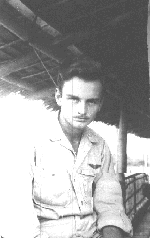
June and July were filled with more firebombing, dive-bombing and strafing runs. Maw, Servantes, Keegan, Lenon, Huzo, BenToc, Hermoza, Baggio and Bellini Pass all saw attacks from the squadron. Fighter sweeps were flown but no enemy fighters were spotted.
Another move was in the works for the 475th, this time to a training area at Linguyon near Manilla. It was time to prepare for the invasion Japan that everyone feared. Aerial gunnery practice was done flying P-38’s at Matagorda Peninsula. A B-26 would tow targets, the P-38’s shot colored shells so they could tell who was hitting the target and how well. Roger loved the P-38, a well-coordinated plane with its counter-rotating props, and a armament package that was contained in the nose.
Roger traveled via LST (landing ship tank) from Linguyan to Okinawa. One night at Okinawa harbor Roger heard some light bombers coming in. It was too dark to see anything. Bombs started dropping everywhere. A 90mm anti-aircraft shell exploded directly over Roger’s head. He dropped to the ground, listening to the whistle and screech of shrapnel flying through the air.
August saw him moving to Ie Shima. It was a field made of white coral that made landing a bit tricky. After the two "BOMBS" were dropped, everyone was certain that the end of the war was near. Roger was on hand when the Japanese "Surrender Betty" landed on the strip at Ie Shima, bringing the Japanese surrender delegates, and signaling the end of the war. Soon after he and the rest of the 432nd Squadron were sent to Kimpo Field, Korea. Here Roger made his last flights in his P-38, and after receiving his orders to return home, he left "The Lodger" on the ramp at Kimpo and returned home on a ship. Lieutenant Roger Palmer saw his part of the war end on February 21, 1946, when he was finally discharged from the Air Corp.
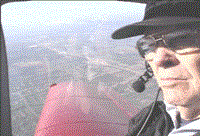
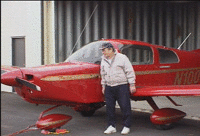
He returned to Ohio, doing electronic repair work until he purchased a movie theater and bar. Roger helped start Butler County Warbirds in 2000, as well. We regret to say that Roger passed away in November of 2003. He will be sorely missed by all of us at BCW, as well as the airshow community.
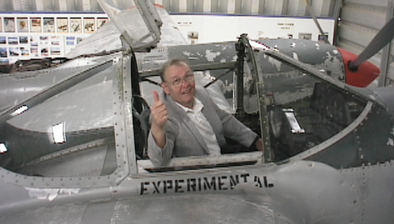
Aircraft Flown by Roger:
